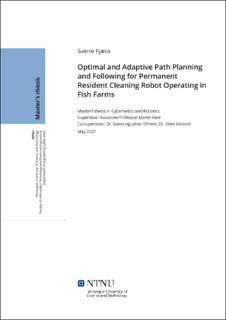| dc.contributor.advisor | Føre, Martin | |
| dc.contributor.advisor | Ohrem, Sveinung Johan | |
| dc.contributor.advisor | Kelasidi, Eleni | |
| dc.contributor.author | Fjæra, Sverre | |
| dc.date.accessioned | 2021-09-23T18:52:26Z | |
| dc.date.available | 2021-09-23T18:52:26Z | |
| dc.date.issued | 2021 | |
| dc.identifier | no.ntnu:inspera:76427839:46775427 | |
| dc.identifier.uri | https://hdl.handle.net/11250/2781051 | |
| dc.description.abstract | Denne oppgåva presenterar resultata frå matematiske simuleringar av ein autonom undervanns notvaskarrobot som skal brukast i eit havbruksmiljø for å forhindra ei av hovedutfordringane i oppdrettsnæringa; biobegroing på merdstrukturen. Vidare, fokuserar rapporten på å løyse bevegelse planleggingsproblemet ved å bruke Elastic Band Method (EBM). EBM blei utvikla i MATLAB og implementert i FhSim for simulering av Mithal sitt moderne robot konsept for forhindring av biobegroing, Remora, og med ein meir konvensjonell Remotely Operated Vehicle (ROV) for samanlikning av meir tradisjonelle reingjeringsmetodar, samt demonstrere anvendelegheita til EBM i forskjellige robotsystem under vann. Ein serie trinnvise simuleringseksperiment for testing av metoden er presentert, og startar med simuleringar for å verifisere grunnleggjande element før meir komplekse operasjonar som liknar faktisk autonome operasjonar for forhindring og reingjering av biobegroing har blitt gjennomført:
• Roboten sin opphavlege bane blir valt av ein operatør i forkant av operasjonen, deretter tilpassar EBM banen i kvart tidssteg for å unngå dei tilførte statiske og dynamiske hindringane og finner ein gjennomførleg alternativ bane.
• Havstraum blei introdusert og deformererte dermed merda sin nettstruktur. Planleggarens evne til å tilpasse banen rundt hindringane og kompensere for miljøforstyrringane blei evaluert.
• Til slutt blei forstyrringane kombinert i ein realistisk not-reingjeringsprosedyre med tilført kompleksitet i form av at roboten må returnere til dokkingstasjonen (gitt som eit fast punkt) for å lade batteriet under operasjonen, før den fortset der den slapp.
Gjennom dei forskjellige eksperimenta viste tidskompleksiteten til metoden lovande resultat, som tyder på at metoden kan brukast i sanntidsapplikasjonar. Moglegheita for å stille inn EBM til ønska oppførsel gjorde at roboten unngikk både statiske og dynamiske hindringar medan systemet var utsett for havstraum. Dei same resultata var observert etter simulering av ROV’en, noko som indikerer at metoden kan bli brukt i fleire applikasjonar under vann i eit havbruksmiljø. Som resultata viste, kan metoden være egna for bruk på eit spesiallaga køyretøy som er designa for å krabbe på nettet, i tillegg til konvensjonelle ROV’ar, i eit dynamisk miljø. Metoden bør bli, og er planlagt, testa i ein verkeleg situasjon i eit simulert miljø som har til hensikt å likne ei oppdrettsmerd i eit laboratorieforsøk etter denne oppgåva for å verifisere resultata frå dei numeriske simuleringane.
Resultata frå denne oppgåva har blitt sendt inn som eit samandrag til OCEANS 2021 og er lagt ved i Appendix B. Eksperimentell validering av det utvikla konseptet i laboratorie- og feltforsøk er planlagd og er sikta mot ein tidskriftpublikasjon. | |
| dc.description.abstract | This thesis presents the results obtained from mathematical simulations of an autonomous underwater net cleaning robot to be used in an aquaculture environment to prevent one of the main challenges in the fish farming industry; biofouling on the fish cage structure. Furthermore, the report focuses on solving the motion planning problem with the use of the Elastic Band Method (EBM). The EBM was developed in MATLAB and implemented in FhSim for simulations with Mithal’s state of the art biofouling prevention robotic concept Remora, and with a conventional free-swimming Remotely Operated Vehicle (ROV) for comparison with more traditional cleaning solutions to demonstrate the applicability of the EBM in different underwater robotic systems. A series of stepwise simulation experiments for testing the method are presented, starting with simulations to verify basic elements before more complex operations resembling actual autonomous biofouling prevention and cleaning operation was conducted:
• The robot’s initial path is chosen in advance of the operation before the EBM adapts the path in each time-step to avoid the added static and dynamic regions of avoidance and finds a new feasible alternative path.
• Ocean current was introduced, and thus deforming the net structure of the fish cage. The planner’s ability to adapt the path around the regions of avoidance while compensating for the environmental disturbances was evaluated.
• Lastly, the disturbances were combined with a realistic net-cleaning procedure with added complexity in the vehicle needing to return to a docking station (provided as a fixed point) to recharge during the operation before continuing where it left off.
Through the various experiments, the time complexity of the method showed promising results, implying use in a real-time application. The tuning possibilities of the EBM made obstacle avoidance possible with both static and dynamic regions of avoidance, with ocean current deforming the net. The same was obtained during the simulations of the ROV, indicating that the method can be used in several underwater aquaculture applications on multiple vehicle types. As the results showed, the method might be suitable for use on a specialised vehicle designed to crawl on the net, as well as a conventional ROV, in a dynamic aquaculture environment. The method should be and are planned to be tested in a real-life situation in a simulated environment aimed to resemble a fish cage in a lab trial after this thesis to verify the results obtained from the numerical simulations.
The results of this thesis have been submitted as an abstract to OCEANS 2021 and are attached in Appendix B. Experimental validation of the developed concepts in lab and field trials are planned and will target journal publication. | |
| dc.language | eng | |
| dc.publisher | NTNU | |
| dc.title | Optimal and Adaptive Path Planning and Following for Permanent Resident Cleaning Robot Operating in Fish Farms | |
| dc.type | Master thesis | |
